|
BULB LOG 03 --- 18th January 2006
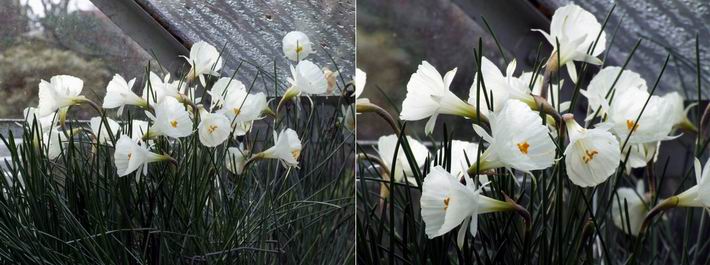
Narcissus 'Camoro' x2
Narcissus 'Camoro', Henry Taylor's fine hybrid between Narcissus cantabricus monophyllus and N. romieuxii, is in full flower now with its crystalline white flowers. It has a good scent which it gets from the seed parent. All N. cantabricus have a good scent but N. romieuxii has very little scent and I have found that the hybrids between these two species have a sweet scent nearer to that of N.cantabricus.
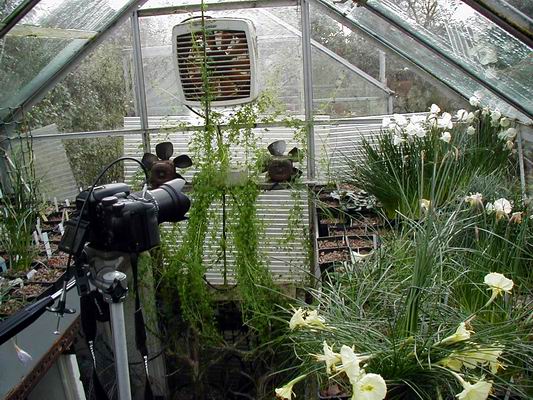
Taking picture
What an interest there has been in my new camera, check out the thread on the forum if you have not seen it already. I am very pleased with it and should have mentioned that other essential feature in a camera, as far as I am concerned, the facility to attach a remote cable release. I am now almost back to the same set up I had with my Olympus OM1, a good zoom lens, a sturdy tripod and a cable release. With this lens I am now able to work at a reasonable distance from the subject, this picture shows the exact position of the camera for both the above shots.
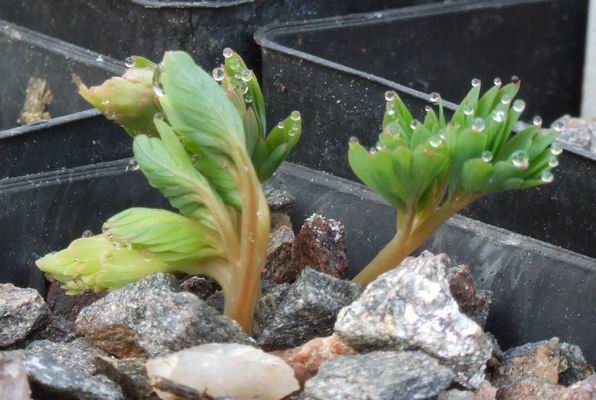
Corydalis paschei
I am sure I have showed you this in the past but I never cease to be amazed by the water droplets, hanging like little diamonds, which always form on the newly emerging leaves of most Corydalis.
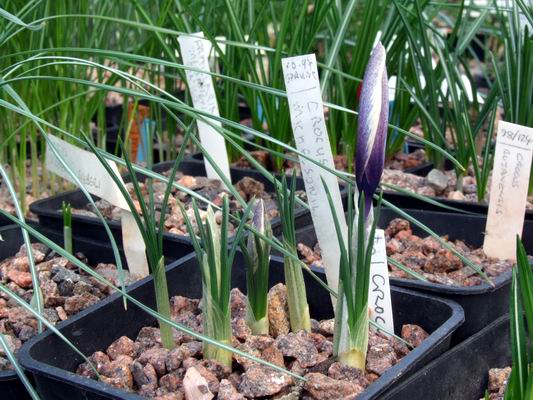
Crocus michelsonii
Having been bemoaning the slow progress of the bulbs due to the cold weather I am now amazed by the difference a few days and a few extra degrees can make. Crocus michelsonii was nowhere to be seen last week and now the first flower is ready to open. I will wait a few days for the others to show their flowers then I will take it into the kitchen for some extra heat to open the flowers and get the pollen flowing so I can fertilise it. This will greatly increase the chance of me getting more seeds to set on this still very rare crocus.
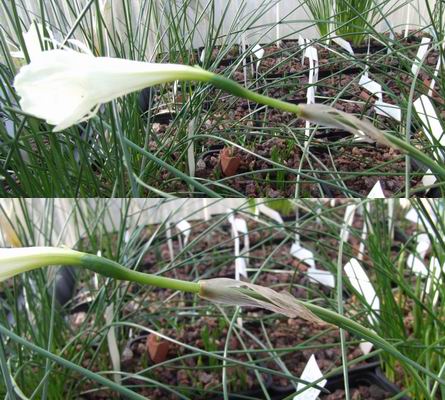
Narcissus cantabricus foliosus
The top picture was taken with the auto focus system on the normal setting and you can see that it has focused on the background, which has much more contrast, rather than on the subject in the foreground. I switched to manual focus for the lower shot and with the ability to magnify the centre of the viewing screen I was able to sharpen the focus precisely on the subject. I want to show the pedicel, the flower stem, which rises from the main stem, the scape, to the narcissus flower, I first had to peel back the spathe, the papery membrane that is found on all narcissus. The presence or absence as well as the length of the pedicel is a feature often used by the taxonomists to separate the different species of narcissus. The pedicel is absent in Narcissus cantabricus, except for N. cantabricus var foliosus where it can vary from 9mm to 17mm!! Do you ever get a feeling that taxonomists make up the rules to suit themselves?
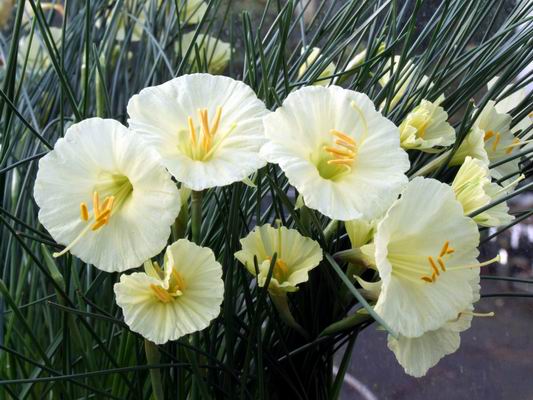
Narcissus romieuxii JCA805
That great collection by Jim Archibald of Narcissus romieuxii JCA805 has given rise to perhaps the majority of forms of N. romieuxii that we all grow. They vary from almost white to intense yellow and the flowers can be small and funnel shaped or wide open and petunioide like the one above - I love them all for the delight that they bring in our deepest winter.

Narcissus romieuxii 'Craigton Gem'
Narcissus romieuxii 'Craigton Gem' was raised seed raised from our own seed taken from JCA805 and I named it because of its vigour, rate of increase and willingness to flower well every year. It can also appear smaller flowered and shorter on the stem than some of the others depending on how it is grown. This was a hand held macro shot and the full frame has been reduced in size, for the web, with no cropping and, on the right, the anther is the full size cropped out of this image taken at 2592 x 1944 pixels.

Narcissus romieuxii rifanus
I received this plant as bulbs under the title Narcissus romieuxii rifanus but it does not seem to fit into the description of var. rifanus to me. It is still a very lovely form of romieuxii with the style and anthers being much exerted from the rolled back corona.

Narcissus romieuxii mesatlanticus
One of the problems with growing so many Narcissus in such a small space is they have to compete with each other for the light which is not that good in our winter at the best of times. This poor light causes the stems and leaves to grow taller than they would in ideal conditions. You can see that these Narcissus romieuxii mesatlanticus, some of which have been flowering since late October, are still in full flower but they are now flopping all over each other and I need to tie them up. It is not just the narcissus that go this way but all the bulbs are affected by so much close competition. It does not prevent them growing well and flowering, it just makes them look a bit untidy.
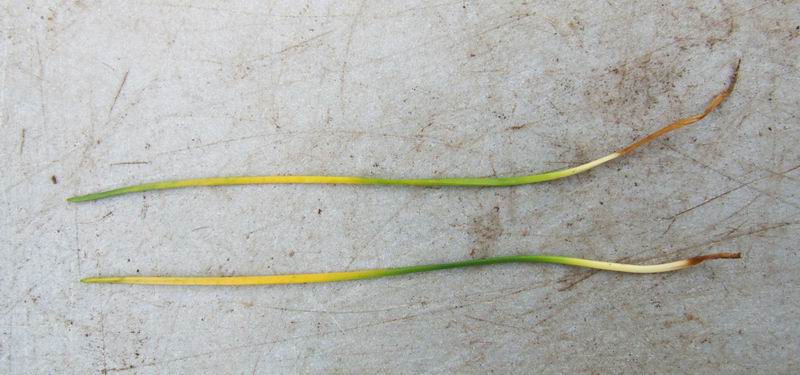
Narcissus leaves with yellow
Occasionally you may notice some of your Narcissus leaves with yellow areas like these. This is caused by some wet rot attacking the base of the leaves under the ground, seen as the brown areas on the right. It is best to remove these leaves by tugging them and you should find that they come off with little resistance.
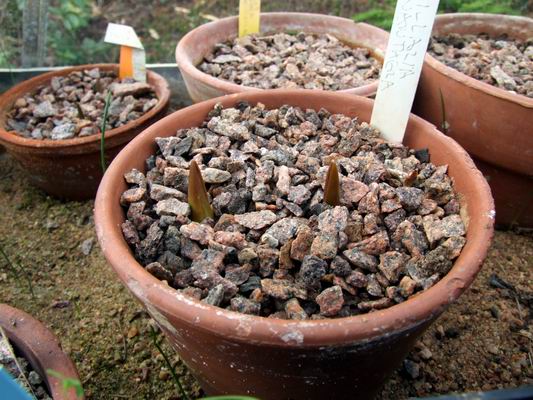
Fritillaria stenanthera
Also since last week more of the frits are starting to appear - Fritillaria stenanthera is always among the first to flower for us. Checking back the frits are probably about a week or two behind where they were this time last year but that is good as they flowered way too early last year only to be hit as our winter weather returned big time when they least expected it.
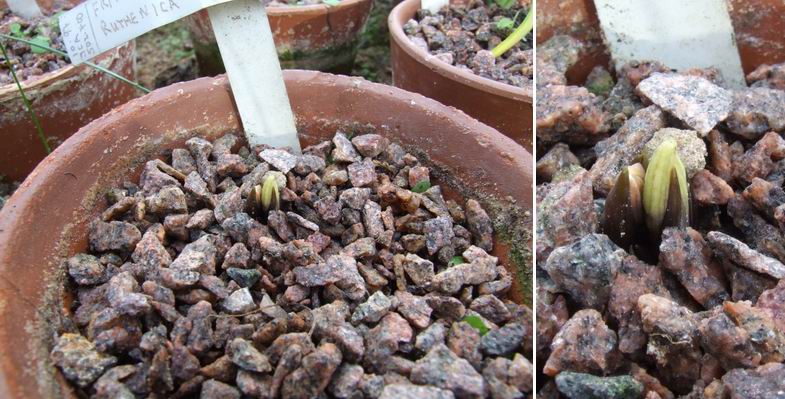
Fritillaria ruthenica
This Fritillaria ruthenica has the flower buds well formed even as it comes through the grit; this is a typical reaction of some bulbs when the winter temperatures are not cold enough and they start to open their flowers underground. Ideally we want a cold, but not freezing, winter to hold the bulbs back then a sudden bright warm spring for them to shoot up and flower beautifully before a warm dry summer - dream on.
^ back to the top ^
|

